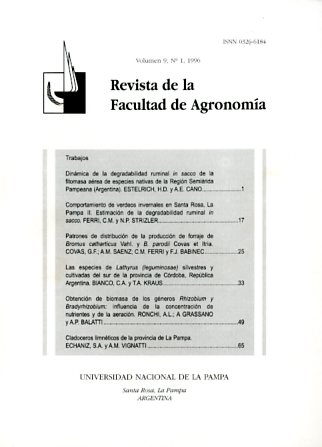Biomass production of Bradyrhizobium and Rhizobium strains: effect of media nutrient concentration and aeration
Keywords:
Biomass productions, Rhizobium, Bradyrrizobium,Abstract
This paper reporta a wofi on growth straina of the Rhizobium and Bradyrllizobium, in a batch system, in order to obtain microorganisms suspension of a very high can concentration. In the process of designing the culture media the influence of the aeration and the nutrient concentration is considered. The experiments were carried out in a er1enmeyers flask on rotatory shaker and in laboratory fermentors. The evolution of cen growth was determined according to measures of optical density, viable cen count and dry weight. Using a selected balanced media and strains such as Rhizobium meliloti B 36, B 399, Rhizobium trifolii A 113, Rhizobium loti LL 22, Rhizobium leguminosarum O 70 and Bradyrhizobium japonicum E 109, E 110 and E 45, it was possible to obtain microorganisms concentrations of 6 x 1010 to 1 x 1011 viable cell ml in 48 and 96 hour processes, corresponding to dry weight concentrations higher than 10 gIl. The osmotical presure in the selected medium was in the order of 300 miliosmoles. The modifications introduced in the culture media to achieve high microorganisms concentration did not alter the nitrogen fixation pacíty of the strains.
Downloads
References
BALANI A.P., MAllA l.A, MOREnl E. 1987. Aeration requeriment of Rhizobium culture. MIRCEN. Joumal of Applied Microbiology and Biotechnology.227-34.
BALANI A.P., MAZZAl.A.,' PASTOR M.O. 1991. Effect of media nutrient concentration on growth of Bradyrtlizobium japonicum. Tropical Agriculture.68:215-218.
BALANI A.P. 1992. Diseño de medios de cultivo. En: Producción de Inoculantes para Leguminosas. Tecnología de las fermentaciones aplicadas a los géneros Rhizobium y Bradyrtlizobium. Ediciones Trabuco. La Plata. Argentina. 63-127.
COOPER C.M., FERST G., MILLESA 1944. Gas liquid contactor. Industrial and Engineering Chemistry. 36:504-509.
KOCH A 1981. Growth Measurement. In Manual of methods general bacteriology. Whashington D.C. American Society for Microbiology. 179-207.
LOPRETO C.P., MAZZA l.A., BALAnl AP. 1973. Producción de inoculantes para soja. Revista Facultad de Agronomía. La Plata XLIX: 201-212.
PIMENTEL,G.F. 1958. Curso de estadrstica experimental. Ed. Hemisferio Sur S.A. 173-176.
PIRT S.J. 1975. Oxygen demand supply. In Principies of microbes and cell cultivation. Oxford: Blackwel Scientific Publication. 81-106.
ROUGHLEY R.J. 1985. Products and quality contents of Iegume seed inoculant in Australia. In Proceeding of the Workshop on Rhizobium llegume inoculant Porto Alegre. R.S. Brasil. 37-42.
ROUGHLEY R.J. 1988. Legume inoculanls; their technology and application.Nitrogen Fixation by Legumes. In Mediterranean Agriculture. Edited by Beck and Materon. 259-267.
UMBREIT W.w., BURRIS R.H., SAUFFER J.F. 1972. The Warburg constant volume respirometer. Manometric Techníques. Burguess Publishing Company, 1-17.
VINCENT J.M. 1970. A manual for the practical study of the rcot nodule bacteria.Blackwell Scientific Publication Oxford. 163 pago
VINCENT J.M. 1977. Rhizobium : General microbiology. In A Treatise on Dinitrogen Fixation. Seco 111. Hardy and Silver (Eds). John Wiley and SonsoNew York 277-366.
VINCENT J.M. 1980. Australian studies of Iegurne/Rhizobium symbiosis. Rhízobium News Letler. 25.
Downloads
Published
Issue
Section
License
La Editorial de la Universidad Nacional de La Pampa (EdUNLPam) exigirá a los/as autores/as la firma del siguiente documento:
La EdUNLPam lleva a cabo la publicación del artículo: (Título del Artículo) en SEMIÁRIDA Rev.Fac.Agron UNLPam ISSN 2362-4337 (impresa) ISSN 2408-4077 (en línea), del cual el/los abajo firmantes son autores de una o más partes. En el mismo acto, el/los autores entregan exclusivamente a la EdUNLPam todos sus derechos protegidos por las leyes de propiedad intelectual que rigen en la Argentina para reproducir, publicar, editar, fijar, comunicar y transmitir públicamente en cualquier formato o medio impreso o electrónico, inclusive internet, el artículo enviado a publicación e incluirlo en índices o bases de datos nacionales e internacionales. A cambio, la EdUNLPam entrega a los autores la autorización para la publicación o reimpresión con ines académicos y educativos en cualquier libro o medio de divulgación, con la sola obligación de citar el artículo original publicado en la EdUNLPam. Cada autor acuerda en que el material provisto a la EdUNLPam es un trabajo original, que no ha sido impreso o publicado en cualquier otro medio con anterioridad y que no vulnera derechos de terceros. El Primer autor tendrá la posibilidad de leer y corregir el artículo ya editado como “prueba de galera”, pero si el autor no devolviera esas correcciones de la prueba de galera dentro del tiempo especificado, el proceso de producción y publicación podrá proseguir sin la aprobación del autor. El/los autor/es no recibirán compensación monetaria de la EdUNLPam por el uso del material contenido en este artículo y asumen la responsabilidad de las opiniones vertidas en él.






.png)



22.png)



.jpg)




.jpg)
